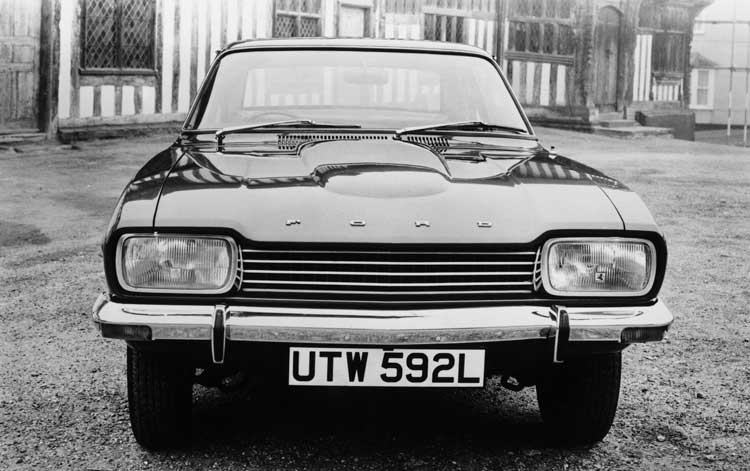Ford Capri
Giles Chapman on how Ford made motorists' sporting dreams come true

The Ford Capri was born out of commercial ruthlessness. It wasn't developed on a hunch or an inspired whim; it was coldly calculated, its sporty persona precisely cut to the millimetre, its design details - some of them pretty tacky - decided after sober debate between stylist and accountant.
The Ford Capri was born out of commercial ruthlessness. It wasn't developed on a hunch or an inspired whim; it was coldly calculated, its sporty persona precisely cut to the millimetre, its design details - some of them pretty tacky - decided after sober debate between stylist and accountant.
And yet, from this clinical process, a car emerged that the British took to their hearts for its easy style, low running costs and, in some versions, he-man performance. We loved the Capri so much that, in its twilight years of 1985 and 1986, it was made solely for the British market, and any new Ford coupé since - Probe, Cougar, the recent Visos - is invariably hailed as the "new Capri" by breathless car magazines.
The Capri was a Mustang for Europe, and the Ford Mustang itself was a nifty, compact sporty car aimed at America's baby-boom generation of cash-rich singletons. The demographic in Europe, which endured post-war penny-pinching until the early 1960s, was rather different but the execution was identical, albeit on a smaller scale.
Under the codename "Colt", work began in 1965. The engineering was overseen in Essex and the styling in Germany under the skilful tutelage of Uwe Bahnsen. The engineering was straightforward because the Capri shared many unseen components with the Escort, which meant a front-mounted engine and rear-wheel drive. However, provision was made for 2- and 3-litre engines never offered in the Escort, and this meant that the bigger-engined Capris would always be light but powerful beasts.
The fastback styling, however, was a cunning mixture of everyday practicality, a low roof line and groovy touches, including the hockey stick-like crease and curvaceous window line along the sides, and the fake air intakes in front of the rear wheel arches, which lent a modicum of sporting cred to the drizzly A-roads of middle Britain. The cockpit took plastic and fake wood and melded them into a pseudo-sports car cocoon.
To anyone accustomed to thoroughbred European small coupés from the likes of Lancia, Alfa Romeo and Porsche, the Capri was a neo-Detroit horror. To anyone who could never afford such cars, however, the Capri was the answer to a prayer. Ford's advertising slogan for the Capri's January 1969 launch - "The Car You Always Promised Yourself" - was as sharp as the car's vinyl roof and ersatz alloy wheels.
The marketing savvy continued from the day, in March that year, that the Capri hit showrooms. When Ford parked a gleaming new Capri outside every railway station in the south-east, the ruse worked brilliantly: weary commuters decided that this was the time to make good on that promise to themselves. In 1970, almost a quarter of a million Capris were sold, meaning one in every four European Fords was a Capri. The millionth was built in August 1973.
Looking back, devotees make much of the 3-litre Capri, and also of the 2,600cc and 3,100cc versions - roadgoing editions of racing models sold in tiny numbers to qualify them as "production" cars. All of these were potent and fine handling cars, yet the Capri typically sold in Britain was actually a 1,600cc with L, GL or XL trim and a four-speed gearbox, and this couldn't even manage 100mph. Punters liked the looks but they weren't overly concerned about high performance. They also loved the prices: the base 1,300cc, a car for the truly timid or frugal driver, cost just £890, while even a peppy 2,000GT was a mere £1,088.
What all these cars had in common, though, was that super-soaraway Seventies styling, and the capacity to take two children or two contorted adults in the cramped back seats. Front disc brakes and excellent rack-and-pinion steering were common factors, too, but initially you had to fork out extra for seatbelts.
It proved tricky to repeat the impact of the first Capri. When, in 1972, Henry Ford Jnr viewed a prototype for a Capri replacement without the car's distinctively rounded rear quarter-window, he barked: "This ain't Capri" and ordered a redesign. Hence the Capri II of 1974 updated the basic profile while offering Ford's first ever hatchback, and the Capri III four years later simply sharpened the look up with four headlights. Consequently, despite the late-life fillip of the terrific fuel-injected 2.8i model in 1981, the vitality of the original Capri slowly evaporated over its 18-year lifespan. The car's cultural status shifted, too: in the 1970s, it appeared in the blokeish cop show The Professionals; in the Eighties, it was the wheels of choice for Derek Trotter in Only Fools and Horses. Capri Man, in his sideburns and flares, was in style retreat from day one.
But none of that detracts from the Capri's role as a motoring democratiser. In the same way that the Ford Model T put the common man on wheels, so the Capri gave the hard-up family motorist a sporty coupé that shared its looks with the very same cars that dominated the European Touring Car championships in 1971 and 1972. The production totals speak for themselves.
Between 1969 and 1986, 1,886,647 Capris were built in Cologne, Germany, and at Halewood in Britain, and, of those, 1,172,900 were MkIs. Still, when did you last see one of these 1970s icons in all its gaudy glory? Undoubtedly not recently, because with the throwaway commodity value inherent in virtually any old Ford, few peachy examples survive.
Join our commenting forum
Join thought-provoking conversations, follow other Independent readers and see their replies
Comments
Bookmark popover
Removed from bookmarks